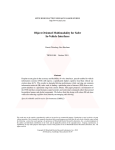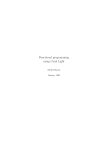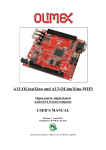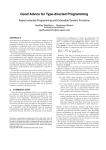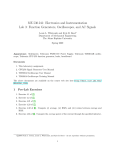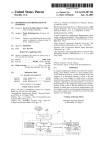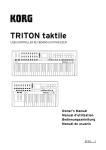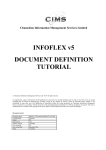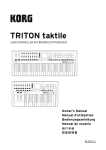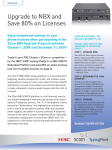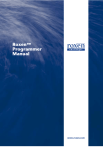Download Some Useful Lisp Algorithms: Part 1
Transcript
MITSUBISHI ELECTRIC RESEARCH LABORATORIES
http://www.merl.com
Some Useful Lisp Algorithms: Part 1
Richard C. Waters
TR91-04
December 1991
Abstract
Richard C. Waters Chapter 3 Ïmplementing Queues in Lisp¨(co-authored by P. Norvig) presents
several different algorithms for implementing queues in Lisp. It discusses why the obvious listbased implementation of queues is inefficient and the particular situations where more complex
implementations are appropriate.
This work may not be copied or reproduced in whole or in part for any commercial purpose. Permission to copy in whole or in part
without payment of fee is granted for nonprofit educational and research purposes provided that all such whole or partial copies include
the following: a notice that such copying is by permission of Mitsubishi Electric Research Laboratories, Inc.; an acknowledgment of
the authors and individual contributions to the work; and all applicable portions of the copyright notice. Copying, reproduction, or
republishing for any other purpose shall require a license with payment of fee to Mitsubishi Electric Research Laboratories, Inc. All
rights reserved.
c Mitsubishi Electric Research Laboratories, Inc., 1991
Copyright 201 Broadway, Cambridge, Massachusetts 02139
MERLCoverPageSide2
Mitsubishi Electric Research Laboratories
Technical Report 91-04
Decmeber 15, 1991
by
Richard C. Waters
Abstract
This technical report gathers together three papers that were written during
1991 and submitted for publication in ACM Lisp Pointers. Each paper describes a
useful Lisp algorithm.
Chapter 1 \Supporting the Regression Testing of Lisp Programs" presents a
system called rt that maintains a database of tests and automatically runs them
when requested. This can take a lot of computer time, but does not take any of the
programmer's time. As a result, any bugs found by running the tests|and this is
a lot more bugs than you might think|are essentially found for free.
Chapter 2 \Determining the Coverage of a Test Suite" presents a system called
cover that can help assess the coverage of a suite of test cases. When a suite of test
cases for a program is run in conjunction with cover, statistics are kept on which
conditions in the code for the program are exercised and which are not. Based on
this information, cover can print a report of what has been missed. By devising
tests that exercise these conditions, a programmer can extend the test suite so that
it has more complete coverage.
Chapter 3 \Implementing Queues in Lisp" (co-authored by P. Norvig) presents
several dierent algorithms for implementing queues in Lisp. It discusses why the
obvious list-based implementation of queues is inecient and the particular situations where more complex implementations are appropriate.
Submitted to ACM Lisp Pointers, January, November, and December 1991.
201 Broadway
Cambridge Massachusetts 02139
Publication History:1. First printing, TR 91-04, December 1991
2. Chapter 1 published as \Supporting the Regression Testing of Lisp Programs",
ACM Lisp Pointers, 4(2):47{53, June 1991.
Copyright c Mitsubishi Electric Research Laboratories, 1991
201 Broadway; Cambridge Massachusetts 02139
This work may not be copied or reproduced in whole or in part for any commercial purpose.
Permission to copy in whole or in part without payment of fee is granted for nonprot educational and research purposes provided that all such whole or partial copies include the
following: a notice that such copying is by permission of Mitsubishi Electric Research Laboratories of Cambridge, Massachusetts; an acknowledgment of the authors and individual
contributions to the work; and all applicable portions of the copyright notice. Copying,
reproduction, or republishing for any other purpose shall require a license with payment of
fee to Mitsubishi Electric Research Laboratories. All rights reserved.
1
Lisp Algorithms
1. Supporting the Regression Testing of Lisp Programs
Richard C. Waters
How often have you made a change in a system to x a bug or add a feature and been totally sure that the change did not aect anything else, only to discover weeks or months
later that the change broke something?
In my personal experience, the single most
valuable software maintenance tool is a regression tester, which maintains a suite of tests for a
system and can run them automatically when
the system is changed. The term \regression
testing" is used, because each version of the system being tested is compared with the previous
version to make sure that the new version has
not regressed by losing any of the tested capabilities. The more comprehensive the test suite
is, the more valuable this comparison becomes.
Creating a comprehensive test suite for a
system requires signicant eort, and running
a test suite can require signicant amounts of
computer time. However, given a comprehensive test suite, regression testing detects an impressive number of bugs with remarkably little
human eort.
The rt regression tester presented here supports the regression testing of systems written
in Common Lisp. In addition to being a valuable tool, rt is an interesting example of the
power of Lisp.
The unied nature of the Lisp programming
environment and the fact that Lisp programs
can be manipulated as data allows rt to be implemented in two pages of code. Merely implementing a batch-mode regression tester using
an Algol-like language in a typical programming environment would require much more
code. Implementing a highly interactive system
like rt would be a major undertaking.
User's Manual for RT
The functions, macros, and variables that
make up the rt regression tester are in a package called "RT". The ten exported symbols are
documented below. If you want to refer to these
symbols without a package prex, you have to
`use' the package.
The basic unit of concern of rt is the test.
Each test has an identifying name and a body
that species the action of the test. Functions
are provided for dening, redening, removing,
and performing individual tests and the test
suite as a whole. In addition, information is
maintained about which tests have succeeded
and which have failed.
deftest name form &rest values
Individual tests are dened using the macro
deftest. The identifying name is typically a
number or symbol, but can be any Lisp form.
If the test suite already contains a test with the
same (equal) name, then this test is redened
and a warning message printed. (This warning
is important to alert the user when a test suite
denition le contains two tests with the same
name.) When the test is a new one, it is added
to the end of the suite. In either case, name is
returned as the value of deftest and stored in
the variable *test*.
(deftest
(deftest
(deftest
(deftest
)
)
t-1 (floor 15/7) 2 1/7)
t-1
(t 2) (list 1) (1))
(t 2)
bad (1+ 1) 1)
bad
good (1+ 1) 2)
good
)
)
The form can be any kind of Lisp form. The
zero or more values can be any kind of Lisp
2
R.C. Waters
objects. The test is performed by evaluating
form and comparing the results with the values.
The test succeeds if and only if form produces
the correct number of results and each one is
equal to the corresponding value.
*test* name-of-current-test
The variable *test* contains the name of
the test most recently dened or performed. It
is set by deftest and do-test.
do-test &optional (name *test*)
The function do-test performs the test identied by name, which defaults to *test*. Before
running the test, do-test stores name in the
variable *test*. If the test succeeds, do-test
returns name as its value. If the test fails,
do-test returns nil, after printing an error report on *standard-output*. The following examples show the results of performing two of
the tests dened above.
)
)
(do-test '(t 2))
(t 2)
(do-test 'bad)
nil ; after
Test BAD failed
Form: (1+ 1)
Expected value: 1
Actual value: 2.
printing:
*do-tests-when-defined* default value nil
If the value of this variable is non-null, each
test is performed at the moment that it is dened. This is helpful when interactively constructing a suite of tests. However, when loading a test suite for later use, performing tests
as they are dened is not liable to be helpful.
get-test &optional (name *test*)
This function returns the name, form, and
values of the specied test.
(get-test '(t 2))
) ((t 2) (list 1) (1))
rem-test &optional (name *test*)
If the indicated test is in the test suite, this
function removes it and returns name. Otherwise, nil is returned.
rem-all-tests
This function reinitializes rt by removing
every test from the test suite and returns nil.
Generally, it is advisable for the whole test suite
to apply to some one system. When switching
from testing one system to testing another, it is
wise to remove all the old tests before beginning
to dene new ones.
do-tests &optional (out *standard-output*)
This function uses do-test to run each of
the tests in the test suite and prints a report of
the results on out, which can either be an output stream or the name of a le. If out is omitted, it defaults to *standard-output*. Do-tests
returns t if every test succeeded and nil if any
test failed.
As illustrated below, the rst line of the report produced by do-tests shows how many
tests need to be performed. The last line shows
how many tests failed and lists their names.
While the tests are being performed, do-tests
prints the names of the successful tests and the
error reports from the unsuccessful tests.
)
(do-tests "report.txt")
nil
; the le "report.txt" contains:
Doing 4 pending tests of 4 tests total.
T-1 (T 2)
Test BAD failed
Form: (1+ 1)
Expected value: 1
Actual value: 2.
GOOD
1 out of 4 total tests failed: BAD.
It is best if the individual tests in the suite
are totally independent of each other. However,
should the need arise for some interdependence,
you can rely on the fact that do-tests will run
tests in the order they were originally dened.
pending-tests
When a test is dened or redened, it is
marked as pending. In addition, do-test marks
the test to be run as pending before running it
and do-tests marks every test as pending before running any of them. The only time a test
is marked as not pending is when it completes
successfully. The function pending-tests returns a list of the names of the currently pending tests.
(pending-tests)
) (bad)
3
Lisp Algorithms
continue-testing
This function is identical to do-tests except
that it only runs the tests that are pending and
always writes its output on *standard-output*.
)
(continue-testing)
nil ; after printing:
Doing 1 pending test out of 4 total tests.
Test BAD failed
Form: (1+ 1)
Expected value: 1
Actual value: 2.
1 out of 4 total tests failed: BAD.
Continue-testing has a special meaning if
called at a breakpoint generated while a test is
being performed. The failure of a test to return the correct value does not trigger an error
break. However, there are many kinds of things
that can go wrong while a test is being performed (e.g., dividing by zero) that will cause
breaks.
If continue-testing is evaluated in a break
generated during testing, it aborts the current
test (which remains pending) and forces the
processing of tests to continue. Note that in
such a breakpoint, *test* is bound to the name
of the test being performed and (get-test) can
be used to look at the test.
When building a system, it is advisable to
start constructing a test suite for it as soon as
possible. Since individual tests are rather weak,
a comprehensive test suite requires large numbers of tests. However, these can be accumulated over time. In particular, whenever a bug
is found by some means other than testing, it
is wise to add a test that would have found the
bug and therefore will ensure that the bug will
not reappear.
Every time the system is changed, the entire
test suite should be run to make sure that no
unintended changes have occurred. Typically,
some tests will fail. Sometimes, this merely
means that tests have to be changed to reect
changes in the system's specication. Other
times, it indicates bugs that have to be tracked
down and xed. During this phase, continuetesting is useful for focusing on the tests that
are failing. However, for safety sake, it is always
wise to reinitialize rt, redene the entire test
suite, and run do-tests one more time after you
think all of the tests are working.
How RT Works
The code for rt is shown in Figures 1 & 2.
The rst gure shows the functions for maintaining the suite of tests. For the most part,
the code is self explanatory. However, several
points are worthy of note.
The test suite is represented as a list of test
entries stored in the variable *entries*. The
list begins with a dummy entry of nil so that
insertion and deletion of entries can be done by
side-eect without having to handle an empty
test suite as a special case. Each test entry
contains ve pieces of information:
pend
name
form
vals
defn
A ag that is non-null when the
test is pending.
The name of the test represented
by the test entry.
The form to evaluate when
performing the test.
The values specifying what the
form should return.
A list containing the name, form,
and vals.
For eciency, the entry data structure is
represented as a list where the pend, name, and
form elds are dened in the normal way, and
the vals and defn elds are overlapping tails of
the list.
Get-entry is broken out as a separate function, rather than being part of get-test, because it is a called by do-test as well.
The reason why deftest is a macro instead
of a function is to allow tests to be dened without explicitly quoting the various parts of the
denition.
The copy-list in add-entry is needed to ensure that evaluating a deftest a second time
creates a fresh entry.
A desire to keep the entries on *entries*
in the order that the tests are initially dened
makes the main loop in add-entry somewhat
complex. The loop searches through *entries*
to see if there is a pre-existing test with the
same name as the one being dened. If there
is, the entry is replaced. If not, the new entry
is placed at the end of *entries*.
The error reporting done by get-entry and
4
R.C. Waters
(in-package "RT" :use '("LISP"))
(provide "RT")
(export
'(deftest get-test do-test rem-test
rem-all-tests do-tests pending-tests
continue-testing *test*
*do-tests-when-defined*))
(defvar
(defvar
(defvar
(defvar
(defvar
*test* nil "Current test name")
*do-tests-when-defined* nil)
*entries* '(nil) "Test database")
*in-test* nil "Used by TEST")
*debug* nil "For debugging")
(defstruct (entry (:conc-name nil)
(:type list))
pend name form)
(defun get-test (&optional (name *test*))
(defn (get-entry name)))
(defun get-entry (name)
(let ((entry (find name (cdr *entries*)
:key #'name
:test #'equal)))
(when (null entry)
(report-error t
"~%No test with name ~:@(~S~)."
name))
entry))
(defmacro deftest (name form &rest values)
`(add-entry '(t ,name ,form .,values)))
(defun rem-all-tests ()
(setq *entries* (list nil))
nil)
(defun add-entry (entry)
(setq entry (copy-list entry))
(do ((l *entries* (cdr l))) (nil)
(when (null (cdr l))
(setf (cdr l) (list entry))
(return nil))
(when (equal (name (cadr l))
(name entry))
(setf (cadr l) entry)
(report-error nil
"Redefining test ~@:(~S~)"
(name entry))
(return nil)))
(when *do-tests-when-defined*
(do-entry entry))
(setq *test* (name entry)))
(defun rem-test (&optional (name *test*))
(do ((l *entries* (cdr l)))
((null (cdr l)) nil)
(when (equal (name (cadr l)) name)
(setf (cdr l) (cddr l))
(return name))))
(defun report-error (error? &rest args)
(cond (*debug*
(apply #'format t args)
(if error? (throw '*debug* nil)))
(error? (apply #'error args))
(t (apply #'warn args))))
(defmacro vals (entry) `(cdddr ,entry))
(defmacro defn (entry) `(cdr ,entry))
(defun pending-tests ()
(do ((l (cdr *entries*) (cdr l))
(r nil))
((null l) (nreverse r))
(when (pend (car l))
(push (name (car l)) r))))
Figure 1: The code for the part of rt that maintains the test suite.
add-entry is broken out into the separate function report-error to provide greater uniformity
and facilitating the testing of rt.
It is often advisable to insert a few hooks
in a system that facilitate testing. As illustrated in the next section, the use of the variable *debug* and the associated throw makes it
possible to test the error checking done by rt
without causing error breaks at testing time.
Figure 2 shows the code for running tests.
Except for the format control strings|which,
as always, are convenient but inscrutable|most
of the code is self explanatory. Nevertheless, a
couple of points are interesting.
The catch set up by do-entry is used by
continue-testing to abort out of a test that has
caused an error break. The variable *in-test*
is used as an interlock to make sure that the
function continue-testing will only do a throw
when the appropriate catch exists. The way
do-entry rst sets the pend eld of the entry to
t and then resets it to reect whether the test
has succeeded causes the pend eld to remain t
when a test is aborted.
Because it does a lot of output, do-entries
looks complex. However, it actually does little
more than call do-entry on each pending test.
It was decided that Continue-testing did
not need to have a stream argument, because
continue-testing is only useful when using rt
interactively.
One might be moved to say that the code in
Figures 1 & 2 is too trivial to be an impressive
example of the power of Lisp. However, this
5
Lisp Algorithms
(defun do-test (&optional (name *test*))
(do-entry (get-entry name)))
(defun do-entry (entry &optional
(s *standard-output*))
(catch '*in-test*
(setq *test* (name entry))
(setf (pend entry) t)
(let* ((*in-test* t)
(*break-on-warnings* t)
(r (multiple-value-list
(eval (form entry)))))
(setf (pend entry)
(not (equal r (vals entry))))
(when (pend entry)
(format s "~&Test ~:@(~S~) failed~
~%Form: ~S~
~%Expected value~P: ~
~f~S~^~%~17t~g~
~%Actual value~P: ~
~f~S~^~%~15t~g.~%"
*test* (form entry)
(length (vals entry))
(vals entry)
(length r) r))))
(when (not (pend entry)) *test*))
(defun continue-testing ()
(if *in-test*
(throw '*in-test* nil)
(do-entries *standard-output*)))
(defun do-tests (&optional
(out *standard-output*))
(dolist (entry (cdr *entries*))
(setf (pend entry) t))
(if (streamp out)
(do-entries out)
(with-open-file
(stream out :direction :output)
(do-entries stream))))
(defun do-entries (s)
(format s "~&Doing ~A pending test~:P ~
of ~A tests total.~%"
(count t (cdr *entries*)
:key #'pend)
(length (cdr *entries*)))
(dolist (entry (cdr *entries*))
(when (pend entry)
(format s "~@[~<~%~:; ~:@(~S~)~>~]"
(do-entry entry s))))
(let ((pending (pending-tests)))
(if (null pending)
(format s "~&No tests failed.")
(format s "~&~A out of ~A ~
total tests failed: ~
~:@(~f~<~% ~1:;~S~>~
~^, ~g~)."
(length pending)
(length (cdr *entries*))
pending))
(null pending)))
Figure 2: The code for the part of rt that performs tests.
would be taking too narrow a view. The impressive thing about Figures 1 & 2 is not what
they contain, but what the do not have to contain. In particular, most of what you would
have to write to implement rt in other languages is provided by the Lisp environment and
does not have to be written at all.
Consider what it would be like to implement rt in a language such as Ada. Because
of the strong typing in Ada, one would probably be prevented from taking the simple approach of storing each test as a combination of
a testing function to call and a group of data
values. Rather, one would probably have to
dene each test as a separate function of no
arguments. This would allow you to use the
standard Ada compiler to prepare the tests for
execution; however, you would have to write
some amount of code outside of Ada (e.g., shell
scripts in a unix system) to manage the process
of dening and running tests.
For an Ada implementation to support the
interactive running of individual test cases and
reporting of the results, a user-interface module would have to be written. To go beyond this
and allow the interactive (re)denition of tests,
some escape to the surrounding operating system would be required to access the compiler.
To take the nal step of allowing the testing
of a system to be intermixed with debugging,
the implementation would have to be built as
an extension to an interactive programming environment. Like any Lisp system, rt gets the
benet of this at no cost to the implementor
whatever.
An Example Test Suite
Returning to the question of how rt can
best be used, consider Figure 3, which shows
the beginnings of a test suite for rt itself. There
is a bit of gratuitous complexity because the
system is being used to test itself. Nevertheless,
the gure is a good example of what a typical
test suite looks like. The rst three lines of the
6
R.C. Waters
(in-package "USER")
(require "RT")
(use-package "RT")
(defmacro setup (&rest body)
`(do-setup '(progn ., body)))
(defun do-setup (form)
(let ((*test* nil)
(*do-tests-when-defined* nil)
(rt::*entries* (list nil))
(rt::*debug* t)
result)
(deftest t1 4 4)
(deftest (t 2) 4 3)
(values
(normalize
(with-output-to-string
(*standard-output*)
(setq result
(catch 'rt::*debug*
(eval form)))))
result)))
(defun normalize (string)
(let ((l nil))
(with-input-from-string (s string)
(loop (push (read-line s nil s) l)
(when (eq (car l) s)
(setq l (nreverse (cdr l)))
(return nil))))
(delete "" l :test #'equal)))
(rem-all-tests)
(deftest get-test-1
(setup (get-test 't1))
() (t1 4 4))
(deftest get-test-2
(setup (get-test 't1) *test*)
() (t 2))
(deftest get-test-3
(setup (get-test '(t 2)))
() ((t 2) 4 3))
(deftest get-test-4
(setup (let ((*test* 't1)) (get-test)))
() (t1 4 4))
(deftest get-test-5
(setup (get-test 't0))
("No test with name T0.") nil)
(deftest do-test-1
(setup (do-test 't1))
() t1)
(deftest do-test-2
(setup (do-test 't1) *test*)
() t1)
(deftest do-test-3
(setup (do-test '(t 2)))
("Test (T 2) failed"
"Form: 4"
"Expected value: 3"
"Actual value: 4.")
nil)
Figure 3: Some tests of rt itself.
gure specify that the test suite is in the "USER"
package and prepare rt for use.
The function setup is used by the tests to
create a safe environment where experiments
can be performed without aecting the overall test suite in the gure. In preparation for
these experiments, setup denes two example
tests (t1 and (t 2)). Setup captures any output created by form in a string and returns a
list of the lines of output as its rst value. Setup
binds rt::*debug* to t (see Figure 1) and includes an appropriate catch so that the error
checking done by rt can be tested.
The function normalize overcomes a minor
problem in the portability of Common Lisp.
Several of the format control strings in do-entry
and do-entries use the control code ~& (see
Figure 2). Unfortunately, while this is better
than ~% in many situations, it is not guaranteed to behave dierently, and Common Lisp
implementations vary widely in what they do.
Normalize removes any blank lines that result
from ~& acting like ~%.
The rst ve tests in Figure 3 test the function get-test. Even for this trivial function,
several tests are required to get reasonable coverage of its capabilities. Get-test-5, checks
that get-test reports an error when given the
name of a non-existent test.
The last three tests in Figure 3 test the function do-test. The full test suite for rt contains
several more tests of get-test and do-tests,
and some twenty more tests overall.
Acknowledgments
The concept of regression testing is an old
one, and many (if not most) large programming
organizations have regression testers. rt is the
result of ten years of practical use and evolution. Many of the ideas in it came from conversations with Charles Rich and Kent Pitman,
who implemented similar systems.
This paper describes research done at the
mit ai Laboratory. Support was provided by
darpa, nsf, ibm, nynex, Siemens, Sperry, and
mcc. The views and conclusions presented here
are those of the author and should not be interpreted as representing the policies, expressed or
implied, of these organizations.
7
Lisp Algorithms
Obtaining RT
rt is written in portable Common Lisp and
has been tested in several dierent Common
Lisp implementations. The complete source
for rt is shown in Figures 1{2. In addition,
the source can be obtained over the internet
by using ftp. Connection should be made to
the FTP.AI.MIT.EDU machine (internet number 128.52.32.6). Login as \anonymous" and
copy the les shown below. It is advisable to
run the tests in rt-test.lisp after compiling
rt for the rst time on a new system.
In the directory /pub/lptrs/
rt.lisp
rt-test.lisp
re-doc.txt
source code
test suite
brief documentation
The contents of Figures 1 & 2 and the les
above are copyright 1990 by the Massachusetts
Institute of Technology, Cambridge MA. Permission to use, copy, modify, and distribute
this software for any purpose and without fee
is hereby granted, provided that this copyright
and permission notice appear in all copies and
supporting documentation, and that the names
of MIT and/or the author are not used in advertising or publicity pertaining to distribution
of the software without specic, written prior
permission. MIT and the author make no representations about the suitability of this software for any purpose. It is provided \as is"
without express or implied warranty.
MIT and the author disclaim all warranties
with regard to this software, including all implied warranties of merchantability and tness,
in no event shall MIT or the author be liable
for any special, indirect or consequential damages or any damages whatsoever resulting from
loss of use, data or prots, whether in an action
of contract, negligence or other tortious action,
arising out of or in connection with the use or
performance of this software.
8
R.C. Waters
9
Lisp Algorithms
2. Determining the Coverage of a Test Suite
Richard C. Waters
The value of a suite of test cases depends
critically on its coverage. Ideally a suite should
test every facet of the specication for a program and every facet of the algorithms used
to implement the specication. Unfortunately,
there is no practical way to be sure that complete coverage has been achieved. However,
something should be done to assess the coverage of a test suite, because a test suite with
poor coverage has little value.
A traditional approximate method of assessing the coverage of a test suite is to check that
every condition tested by the program is exercised. For every predicate in the program, there
should be at least one test case that causes the
predicate to be true and one that causes it to
be false. Consider the function my* in Figure 4,
which uses a convoluted algorithm to compute
the product of two numbers.
The function my* contains two predicates,
(minusp x) and (minusp y), which lead to four
conditions: x is negative, x is not negative, y
is negative, and y is not negative. To be at all
thorough, a test suite must contain tests exercising all four of these conditions. For instance,
(defun my* (x y)
(let ((sign 1))
(when (minusp x)
(setq sign (- sign))
(setq x (- x)))
(when (minusp y)
(setq sign (- sign))
(setq y (- x)))
(* sign x y)))
Figure 4: An example program.
any test suite that fails to exercise the condition
where y is negative will fail to detect the bug in
the next to last line of the function.
(As an example of the fact that covering
all the conditions in a program does not guarantee that every facet of either the algorithm
or the specication will be covered, consider
the fact that the two test cases (my* 2.1 3)
and (my* -1/2 -1/2) cover all four conditions.
However, they do not detect the bug on the
next to last line and they do not detect the fact
that my* fails to work on complex numbers.)
The cover system determines which conditions tested by a program are exercised by a
given test suite. This is no substitute for thinking hard about the coverage of the test suite.
However, it provides a useful starting point and
can indicate some areas where additional test
cases should be devised.
User's Manual for COVER
The functions, macros, and variables that
make up the cover system are in a package
called "COVER". The six exported symbols are
documented below.
cover:annotate t-or-nil
Evaluating (cover:annotate t) triggers the
processing of function and macro denitions by
the cover system. Each subsequent instance
of defun or defmacro is altered by adding annotation that maintains information about the
various conditions tested in the body.
Evaluating (cover:annotate nil) stops the
10
R.C. Waters
) 43
special processing of function and macro denitions. Subsequent denitions are not annotated. However, if a function or macro that is
currently annotated is redened, the new denition is annotated as well.
The macro cover:annotate should only be
used as a top-level form. When annotation is
triggered, a warning message is printed, and t
is returned. Otherwise, nil is returned.
(setq cover:*line-limit* 43)
(cover:annotate t)
t ; after printing:
;;; Warning: Coverage annotation applied.
) -4
(cover:report) ) ; after printing:
;+ :REACH (DEFUN MY* (X Y)) <1>
)
cover:forget-all
This function, which always returns t, has
the eect of removing all coverage annotation
from every function and macro. It is appropriate to do this before completely recompiling
the system being tested or before switching to
a dierent system to be tested.
cover:reset
Each condition tested by an annotated function and macro is associated with a ag that
trips when the condition is exercised. The function cover:reset resets all these ags, and returns t. It is appropriate to do this before rerunning a test suite to reevaluate its coverage.
cover:report &key fn out all
This function displays the information maintained by cover, returning no values. Fn must
be the name of an annotated function or macro.
If fn is specied, a report is printed showing information about that function or macro only.
Otherwise, reports are printed about every annotated function and macro.
Out, which defaults to *standard-output*,
must either be an output stream or the name
of a le. It species where the reports should
be printed.
If all, which defaults to nil, is non-null then
the reports printed contain information about
every condition. Otherwise, the reports are abbreviated to highlight key conditions that have
not been exercised.
cover:*line-limit* default value 75
The output produced by cover:report is
)T
(cover:report) ) ; after printing:
;- :REACH (DEFUN MY* (X Y)) <1>
(my* 2 2) ) 4
(cover:report) ) ; after printing:
;+ :REACH (DEFUN MY* (X Y)) <1>
(cover:reset)
;
;
;
;
+ :REACH (WHEN (MINUSP X) (SETQ S <2>
- :NON-NULL (MINUSP X) <4>
+ :REACH (WHEN (MINUSP Y) (SETQ S <6>
- :NON-NULL (MINUSP Y) <8>
(my* -2 2)
; + :REACH (WHEN (MINUSP Y) (SETQ S <6>
; - :NON-NULL (MINUSP Y) <8>
)
(cover:report :all t)
; after printing:
;+ :REACH (DEFUN MY* (X Y)) <1>
; + :REACH (WHEN (MINUSP X) (SETQ S <2>
; + :NON-NULL (MINUSP X) <4>
; + :NULL (MINUSP X) <5>
; + :REACH (WHEN (MINUSP Y) (SETQ S <6>
; - :NON-NULL (MINUSP Y) <8>
; + :NULL (MINUSP Y) <9>
Figure 5: Example cover reports.
truncated to ensure that it is no wider than
cover:*line-limit*.
An example. Suppose that the function
my* in Figure 4 has been annotated and that no
other functions or macros have been annotated.
Figure 5 illustrates the operation of cover and
the reports printed by cover:report.
Each line in a report contains three pieces of
information about a point in a denition: +/specifying that the point either has (+) or has
not (-) been exercised, a message indicating the
physical and logical placement of the point in
the denition, and in angle brackets < >, an integer that is a unique identier for the point.
Indentation is used to indicate that some points
are subordinate to others in the sense that the
subordinate points cannot be exercised without
also exercising their superiors. The order of the
lines of the report is the same as the order of
the points in the denition.
Each message contains a label (e.g., :REACH,
:NULL) and a piece of code. There is a point labeled :REACH corresponding to each denition as
11
Lisp Algorithms
a whole and each conditional form within each
denition. Subordinate points corresponding
to the conditions a conditional form tests are
grouped under the point corresponding to the
form. As discussed in detail in the next subsection, the messages for the subordinate points
describe the situations in which the conditions
are exercised. Lines that would otherwise be
too long to t on one line have their messages
truncated (e.g., points <2> and <6> in Figure 5).
The rst three reports in Figure 5 are abbreviated based on two principles. First, if a
point p and all of its subordinates have been
exercised, then p and all of its subordinates are
omitted from the report. This is done to focus
the user's attention on the points that have not
been exercised.
Second, if a point p has not been exercised,
then all of the points subordinate to it are omitted from the report. This reects the fact that
it is not possible for any of these subordinate
points to have been exercised and one cannot
devise a test case that exercises any of the subordinate points without rst guring out how
to exercise p.
An additional complicating factor is that
cover operates in an incremental fashion and
does not, in general, have full information about
the subordinates of points that have not been
exercised. As a result, it is not always possible
to present a complete report. However, one can
have total condence that if the report says that
every point has been exercised, this statement
is based on complete information.
The rst report in Figure 5 shows that none
of the points within my* has been exercised. The
second report displays most of the points in my*,
to set the context for the two points that have
not been exercised. The third report omits <2>
and its subordinates, since they have all been
exercised. The fourth report shows a complete
report corresponding to the third abbreviated
report.
cover:forget &rest ids
This function gives the user greater control over the reports produced by cover:report.
Each id must be an integer identifying a point.
All information about the specied points (and
their subordinates) is forgotten. From the point
of view of cover:report, the eect is as if the
points never existed. (A forgotten point can
be retrieved by reevaluating or recompiling the
function or macro denition containing it.) The
example below, which follows on after the end
of Figure 5, shows the action of cover:forget.
(cover:forget 6)
)T
)
; after printing:
(cover:report :all t)
;+ :REACH (DEFUN MY* (X Y)) <1>
; + :REACH (WHEN (MINUSP X) (SETQ S <2>
; + :NON-NULL (MINUSP X) <4>
; + :NULL (MINUSP X) <5>
)
(cover:report)
; after
;All points exercised.
printing
The abbreviated report above does not describe any points, because every point in my*
that has not been forgotten has been exercised.
It is appropriate to forget a point if there is
some reason that no test case can possibly exercise the point. However, it is much better to
write your code so that every condition can be
tested.
(Point numbers are assigned based on the
order in which points are entered into cover's
database. In general, whenever a denition is
reevaluated or recompiled, the numbers of the
points within it change.)
The way conditionals are annotated.
Figure 6 shows a le that makes use of cover.
Figure 7 shows the kind of report that might be
produced by loading the le. Because, maybeand g are the only denitions that have been
annotated, these are the only denitions that
are reported on. The order of the reports is
the same as the order in which the denitions
were compiled. The report on g indicates that
the tests performed by run-tests exercise most
of the conditions tested by g. However, they
do not exercise the situation in which the case
statement is reached, but neither of its clauses
is selected.
There are no points within maybe-, because
the code for maybe- does not contain any conditional forms. It is interesting to consider the
precise points that cover includes for g.
12
R.C. Waters
(in-package "USER")
(require "COVER" ...)
(defmacro maybe+ (x y)
`(if (numberp ,x) (+ ,x ,y)))
(cover:annotate t)
(defmacro maybe- (x y)
`(if (numberp ,x) (- ,x ,y)))
(defun g (x y)
(cond ((and (null x) y) y)
(y (case y
(1 (maybe- x y))
(2 (maybe+ x y))))))
(cover:annotate nil)
;+ :REACH (DEFMACRO MAYBE- (X Y)) <1>
;+ :REACH (DEFUN G (X Y)) <2>
; + :REACH (COND ((AND # Y) Y) (Y ( <3>
; + :REACH (AND (NULL X) Y) <9>
; + :FIRST-NULL (NULL X) <11>
; + :EVAL-ALL Y <12>
; + :FIRST-NON-NULL (AND (NULL X) <5>
; + :FIRST-NON-NULL Y <7>
; + :REACH (CASE Y (1 (MAYBE- X Y <13>
;
+ :SELECT 1 <15>
;
+ :REACH (IF (NUMBERP X) (- X <18>
;
+ :NON-NULL (NUMBERP X) <20>
;
+ :NULL (NUMBERP X) <21>
;
+ :SELECT 2 <16>
;
- :SELECT-NONE <17>
; + :ALL-NULL <8>
(defun h (x y) ...)
Figure 7: The report created by Figure 6.
(cover:reset)
(run-tests)
(cover:report :out "report" :all t)
Figure 6: Example of a le using cover.
When cover processes a denition, a cluster of points is generated corresponding to each
conditional form (i.e., if, when, until, cond,
case, typecase, and, and or) that is literally
present in the program. In addition, points are
generated corresponding to conditional forms
that are produced by macros that are annotated
(e.g., the if produced by the maybe- in the rst
case clause in g). However, annotation is not
applied to conditionals that come from other
sources (e.g., from macros that are dened outside of the system being tested). These conditionals are omitted, because there is no reasonable way for the user to know how they relate
to the code, and therefore there is no reasonable way for the user to devise a test case that
will exercise them.
The messages associated with a point's subordinates describe the situations under which
the subordinates are exercised. The pattern of
messages associated with case and typecase is
illustrated by the portion (reproduced below)
of Figure 7 that describes the case in g.
;
;
;
;
+ :REACH (CASE Y (1 (MAYBE- X Y <13>
+ :SELECT 1 <15>
+ :SELECT 2 <16>
- :SELECT-NONE <17>
There are two subpoints corresponding to the
two clauses of the case. In addition, since the
last clause does not begin with t or otherwise,
there is an additional point corresponding to
the situation where none of the clauses of the
case are executed.
The pattern of messages associated with a
cond is illustrated by the portion (reproduced
below) of Figure 7 that describes the cond in g.
;
;
;
;
;
+ :REACH (COND ((AND # Y) Y) (Y ( <3>
+ :REACH (AND (NULL X) Y) <9>
+ :FIRST-NON-NULL (AND (NULL X) <5>
+ :FIRST-NON-NULL Y <7>
+ :ALL-NULL <8>
There are subordinate points corresponding to
the two clauses and the situation where neither
clause is executed. There is also a point <9>
corresponding to the and that is the predicate
of the rst cond clause. This point is placed
directly under <3>, because it is not subordinate
to any of the individual cond clauses.
The treatment of and (and or) is particularly interesting. Sometimes and is used as a
control construct on a par with cond. In that
situation, it is clear that and should be treated
analogously to cond. However, at other times,
and is used to compute a value that is tested
by another conditional form. In that situation,
cover could choose to treat and as a simple
function. However, it is nevertheless still reasonable to think of an and as having conditional
points that correspond to dierent reasons why
Lisp Algorithms
the and returns a true or false value. It is wise
to include tests corresponding to each of these
dierent reasons.
The pattern of messages associated with an
and is illustrated by the portion (reproduced
below) of Figure 7 that describes the and in g.
(cover:report :all t)
; + :REACH (AND (NULL X) Y) <9>
; + :FIRST-NULL (NULL X) <11>
; + :EVAL-ALL Y <12>
The nal subpoint corresponds to the situation
where all of the arguments of the and have been
evaluated. The and then returns whatever the
nal argument returned.
Figure 6 illustrates a batch-oriented use of
cover. However, cover is most eectively
used in an interactive way. It is recommended
that you rst create as comprehensive a test
suite as you can and capture it using a tool such
as rt [1]. The tests should then be run in conjunction with cover and repeated reports from
cover generated as additional tests are created
until complete coverage of conditions has been
achieved. To robustly support this mode of operation, cover has been carefully designed so
that it will work with batch-compiled denitions, incrementally-compiled denitions, and
interpreted denitions.
How COVER Works
The code for cover is shown in Figures 8,
10, 11, and 13. Figure 8 shows the denition of
the primary data structure used by cover and
some of the central operations. A point structure contains ve pieces of information about a
position in the code for a denition.
hit
id
status
name
subs
Flag indicating whether the point
has been exercised.
Unique integer identier.
Flag that controls reporting.
Logical name.
List of subordinate points.
The hit ag operates as a \time stamp".
When a point is exercised, this is recorded by
storing the current value of the variable *hit*
13
in the hit eld of the point. This method of operation makes it possible to reset the hit ags
of all the points currently in existence without visiting any of them (see the denition of
cover:reset).
The id is printed in reports and used to
identify points when calling cover:forget. The
variable *count* is used to generate the values.
The status controls the reporting of a point.
It is either :SHOW (shown in reports), :HIDDEN
(not shown in reports, but its subordinates may
be), or :FORGOTTEN (neither it nor its subordinates are shown in reports). (cover:forget
changes the status of the indicated points to
:FORGOTTEN.)
The name of a point p describes its position
in the denition containing it. A name has the
form: (label code . superior-name) where label is an explanatory label such as :REACH or
:NULL, code is a piece of code, and superiorname is the name of the point containing p (if
any). Taken together, the label and code indicate the position of p in a denition and the
condition under which it is exercised (see the
discussion of Figure 7).
At any given moment, the variable *points*
contains a list of points corresponding to the
annotated denitions known to cover. (The
function cover:forget-all resets *points* to
nil.) As an illustration of the point data structure, Figure 9 shows the contents of *points*
corresponding to the second report in Figure 5.
It is assumed that *hit* has the value 1.
The function add-top-point adds a new toplevel point corresponding to a denition to the
list *points*. If there is already a point for
the denition, the new point is put in the same
place in the list.
The function record-hit records the fact
that a point has been exercised. This may
require locating the point in *points* using
locate or adding the point into *points* using add-point. record-hit is optimized so that
it is extremely fast when the point has already
been exercised. This allows cover to run with
relatively little overhead. (The details of the
way record-hit and add-point operate are discussed further in conjunction with Figure 13.)
14
R.C. Waters
(in-package "COVER" :use '("LISP"))
(provide "COVER")
(shadow '(defun defmacro))
(export '(annotate report reset forget
forget-all *line-limit*))
(defstruct (point (:conc-name nil)
(:type list))
(hit 0)
(id nil)
(status :show)
(name nil)
(subs nil))
(defvar
(defvar
(defvar
(defvar
(defvar
*count* 0)
*hit* 1)
*points* nil)
*annotating* nil)
*testing* nil)
(lisp:defun forget (&rest ids)
(forget1 ids *points*)
t)
(lisp:defun forget1 (names ps)
(dolist (p ps)
(when (member (id p) names)
(setf (status p) :forgotten))
(forget1 names (subs p))))
(lisp:defun forget-all ()
(setq *points* nil)
(setq *hit* 1)
(setq *count* 0)
t)
(lisp:defun add-top-point (p)
(setq p (copy-tree p))
(let ((old (find (fn-name p) *points*
:key #'fn-name)))
(cond (old (setf (id p) (id old))
(nsubstitute p old *points*))
(t (setf (id p) (incf *count*))
(setq *points*
(nconc *points*
(list p)))))))
(lisp:defun record-hit (p)
(unless (= (hit p) *hit*)
(setf (hit p) *hit*)
(let ((old (locate (name p))))
(if old
(setf (hit old) *hit*)
(add-point p)))))
(lisp:defun locate (name)
(find name
(if (not (cdr name))
*points*
(let ((p (locate (cdr name))))
(if p (subs p))))
:key #'name :test #'equal))
(lisp:defun add-point (p)
(let ((sup (locate (cdr (name p)))))
(when sup
(setq p (copy-tree p))
(setf (subs sup)
(nconc (subs sup) (list p)))
(setf (id p) (incf *count*))
(dolist (p (subs p))
(setf (id p) (incf *count*))))))
(lisp:defun reset () (incf *hit*) t)
Figure 8: The basic data structure used by cover.
((1 :SHOW 1 (#1=(:REACH (DEFUN MY* (X Y))))
((2 :SHOW 1 (#2=(:REACH (WHEN (MINUSP X) (SETQ SIGN (- SIGN)) (SETQ X (- X)))) #1#)
((3 :HIDDEN 1 ((:REACH (MINUSP X)) #2# #1#) NIL)
(4 :SHOW 0 ((:NON-NULL (MINUSP X)) #2# #1#) NIL)
(5 :SHOW 1 ((:NULL (MINUSP X)) #2# #1#) NIL)))
(6 :SHOW 1 (#6=(:REACH (WHEN (MINUSP Y) (SETQ SIGN (- SIGN)) (SETQ Y (- X)))) #1#)
((7 :HIDDEN 1 ((:REACH (MINUSP Y)) #6# #1#) NIL)
(8 :SHOW 0 ((:NON-NULL (MINUSP Y)) #6# #1#) NIL)
(9 :SHOW 1 ((:NULL (MINUSP Y)) #6# #1#) NIL))))))
Figure 9: The contents of *points* corresponding to the second report in Figure 5.
Figure 10 shows the code that prints reports. As can be seen by a comparison of Figures 5 and 9, reports are a relatively straightforward printout of parts of *points* with nesting indicated by indentation and only the rst
part of each point's name shown. The function
report2 supports the abbreviation described in
conjunction with Figure 5.
Annotating denitions. Figure 11 shows
the code that controls the annotation of denitions by cover. The rst time cover:annotate
is called, it uses shadowing-import to install new
denitions for defun and defmacro. Whether or
not annotation is in eect is recorded in the
variable *annotate*. The variable *testing*
is used to make it easier to test cover using
15
Lisp Algorithms
(defvar *line-limit* 75)
(proclaim '(special *depth* *all*
*out* *done*))
(lisp:defun report
(&key (fn nil)
(out *standard-output*)
(all nil))
(let (p)
(cond
((not (streamp out))
(with-open-file
(s out :direction :output)
(report :fn fn :all all :out s)))
((null *points*)
(format out
"~%No definitions annotated."))
((not fn)
(report1 *points* all out))
((setq p (find fn *points*
:key #'fn-name))
(report1 (list p) all out))
(t (format out "~%~A is not annotated."
fn))))
(values))
(lisp:defun fn-name (p)
(let ((form (cadr (car (name p)))))
(and (consp form)
(consp (cdr form))
(cadr form))))
(lisp:defun report1 (ps *all* *out*)
(let ((*depth* 0) (*done* t))
(mapc #'report2 ps)
(when *done*
(format *out*
"~%;All points exercised."))))
(lisp:defun report2 (p)
(case (status p)
(:forgotten nil)
(:hidden (mapc #'report2 (subs p)))
(:show
(cond ((reportable-subs p)
(report3 p)
(let ((*depth* (1+ *depth*)))
(mapc #'report2 (subs p))))
((reportable p)
(report3 p))))))
(lisp:defun reportable (p)
(and (eq (status p) :show)
(or *all*
(not (= (hit p) *hit*)))))
(lisp:defun reportable-subs (p)
(and (not (eq (status p) :forgotten))
(or *all* (not (reportable p)))
(some #'(lambda (s)
(or (reportable s)
(reportable-subs s)))
(subs p))))
(lisp:defun report3 (p)
(setq *done* nil)
(let* ((*print-pretty* nil)
(*print-level* 3)
(*print-length* nil)
(m (format nil
";~V@T~:[-~;+~]~f ~S~g"
*depth*
(= (hit p) *hit*)
(car (name p))))
(limit (- *line-limit* 8)))
(when (> (length m) limit)
(setq m (subseq m 0 limit)))
(format *out* "~%~A <~S>" m (id p))))
Figure 10: The code for the part of cover that prints reports.
rt [1].
Redening defun and defmacro is a convenient approach to use for supporting cover,
however, it is in general a rather dangerous
thing to do. One problem is that for cover
to operate correctly, cover:annotate must be
executed before any of the denitions you wish
to annotate are read. For instance, Figure 6
would not work if an eval-when were wrapped
around the top-level forms as a group.
When annotation is in eect, the new definitions of defun and defmacro use sublis to
replace every instance of if, cond, etc. with special macros c-if, c-cond, etc. (see Figure 13).
Dening forms created by the user (e.g., def
in Figure 13) are typically macros that expand
into defmacro. They are indirectly supported
by cover, as long as their denitions are read
after cover:annotate has been evaluated.
On the face of it, it is not correct to use
sublis to rename forms in code, because every
instance of the indicated symbols is changed,
whether or not they are actually uses of the
indicated forms and whether or not they are in
quoted lists. Nevertheless, cover uses sublis
for two reasons.
First, in contrast to a code walker, sublis is
very simple. (The only understanding of Lisp
structure that cover needs is how to separate
the declarations from the body of a denition,
see the function parse-body.)
Most problems can easy be avoid by resist-
16
R.C. Waters
(lisp:defmacro annotate (t-or-nil)
`(eval-when (eval load compile)
(annotate1 ,t-or-nil)))
(lisp:defun annotate1 (flag)
(shadowing-import
(set-difference '(defun defmacro)
(package-shadowing-symbols *package*)))
(when (and flag (not *testing*))
(warn "Coverage annotation applied."))
(setq *annotating* (not (null flag))))
(lisp:defmacro defun (n argl &body b)
(process 'defun 'lisp:defun n argl b))
(lisp:defmacro defmacro (n a &body b)
(process 'defmacro 'lisp:defmacro n a b))
(lisp:defun parse-body (body)
(let ((decls nil))
(when (stringp (car body))
(push (pop body) decls))
(loop (unless (and (consp (car body))
(eq (caar body)
'declare))
(return nil))
(push (pop body) decls))
(values (nreverse decls) body)))
(defvar *check*
'((or . c-or) (and . c-and)
(if . c-if) (when . c-when)
(unless . c-unless)
(cond . c-cond) (case . c-case)
(typecase . c-typecase)))
(lisp:defun process (cdef def fn argl b)
(if (not (or *annotating*
(find fn
*points*
:key #'fn-name)))
`(,def ,fn ,argl ., b)
(multiple-value-bind (decls b)
(parse-body b)
(setq b (sublis *check* b))
(let ((name
`((:reach
(,cdef ,fn ,argl)))))
`(eval-when (eval load compile)
(add-top-point
',(make-point :name name))
(,def ,fn ,argl ,@ decls
,(c0 (make-point :name
name)
name b)))))))
Figure 11: The code for the part of cover that annotates denitions.
(EVAL-WHEN (EVAL LOAD COMPILE)
(COVER::ADD-TOP-POINT '(NIL :SHOW 0 (#1=(:REACH (DEFUN MY* (X Y)))) NIL))
(LISP:DEFUN MY* (X Y)
(COVER::RECORD-HIT '(NIL :SHOW 0 (#1#) NIL))
(LET ((SIGN 1))
(COVER::RECORD-HIT
'(NIL :SHOW 0 (#2=(:REACH (WHEN (MINUSP X) (SETQ SIGN (- SIGN)) (SETQ X (- X)))) #1#)
((NIL :HIDDEN 0 ((:REACH (MINUSP X)) #2# #1#) NIL)
(NIL :SHOW 0 ((:NON-NULL (MINUSP X)) #2# #1#) NIL)
(NIL :SHOW 0 ((:NULL (MINUSP X)) #2# #1#) NIL))))
(IF (PROGN (COVER::RECORD-HIT '(NIL :HIDDEN 0 ((:REACH (MINUSP X)) #2# #1#) NIL))
(MINUSP X))
(PROGN (COVER::RECORD-HIT '(NIL :SHOW 0 ((:NON-NULL (MINUSP X)) #2# #1#) NIL))
(SETQ SIGN (- SIGN)) (SETQ X (- X)))
(PROGN (COVER::RECORD-HIT '(NIL :SHOW 0 ((:NULL (MINUSP X)) #2# #1#) NIL))
NIL))
...)))
Figure 12: Part of the annotated denition of my* from Figure 4.
ing the temptation to use if, cond, etc. as variable names. Any remaining diculties can be
tolerated because cover is merely part of scaffolding for testing a system rather than part of
the system to be delivered. A subtle diculty
concerns and and or. They are used as type
speciers as well as conditional forms. This
diculty is partly overcome by the type denitions at the end of Figure 13.
Second, the use of sublis supports two key
features of cover that would be very dicult
to support using a code walker. It insures that
only conditional forms that literally appear in
the denition are annotated (as opposed to ones
that come from macro expansions), and yet,
conditionals that come from the expansion of
annotated macros are annotated. (Note that
the literals that turn into conditionals in the
17
Lisp Algorithms
(defvar *fix*
'((c-or . or) (c-and . and) (c-if . if)
(c-when . when) (c-unless . unless)
(c-cond . cond) (c-case . case)
(c-typecase . typecase)))
(proclaim '(special *subs* *sup*))
(lisp:defmacro sup-mac () nil)
(lisp:defmacro def (name args form)
`(lisp:defmacro ,name (&whole w ,@ args
&environment env)
(let* ((*subs* nil)
(*sup*
`((:reach ,(sublis *fix* w))
.,(macroexpand-1
(list 'sup-mac) env)))
(p (make-point :name *sup*))
(form ,form))
(setf (subs p) (nreverse *subs*))
(c0 p *sup* (list form)))))
(lisp:defmacro c (body &rest msg)
(c1 `(list ,body) msg :show))
(lisp:defmacro c-hide (b)
(c1 `(list ,b) (list :reach b) :hidden))
(eval-when (eval load compile)
(lisp:defun c1 (b m s)
`(let ((n (cons (sublis *fix*
(list .,m))
*sup*)))
(push (make-point :name n :status ,s)
*subs*)
(c0 (make-point :name n :status ,s)
n ,b)))
(lisp:defun c0 (p sup b)
`(macrolet ((sup-mac () ',sup))
(record-hit ',p)
.,b)) )
(def c-case (key &rest cs)
`(case ,(c-hide key)
.,(c-case0 cs)))
(def c-typecase (key &rest cs)
`(typecase ,(c-hide key)
.,(c-case0 cs)))
(def c-if (pred
`(if ,(c-hide
,(c then
,(c else
then &optional (else nil))
pred)
:non-null pred)
:null pred)))
(def c-when (pred &rest actions)
`(if ,(c-hide pred)
,(c `(progn ., actions)
:non-null pred)
,(c nil :null pred)))
(def c-unless (pred &rest actions)
`(if (not ,(c-hide pred))
,(c `(progn ., actions) :null pred)
,(c nil :non-null pred)))
(def c-cond (&rest cs)
(c-cond0 (gensym) cs))
(lisp:defun c-cond0 (var cs)
(cond ((null cs) (c nil :all-null))
((eq (caar cs) t)
(c (if (cdar cs)
`(progn .,(cdar cs))
t)
:first-non-null t))
((cdar cs)
`(if ,(c-hide (caar cs))
,(c `(progn .,(cdar cs))
:first-non-null
(caar cs))
,(c-cond0 var (cdr cs))))
(t `(let ((,var
,(c-hide (caar cs))))
(if ,var
,(c var :first-non-null
(caar cs))
,(c-cond0 var
(cdr cs)))))))
(def c-or (&rest ps) (c-or0 ps))
(lisp:defun c-or0 (ps)
(if (null (cdr ps))
(c (car ps) :eval-all (car ps))
(let ((var (gensym)))
`(let ((,var ,(c-hide (car ps))))
(if ,var
,(c var :first-non-null
(car ps))
,(c-or0 (cdr ps)))))))
(lisp:defun c-case0 (cs)
(let ((stuff (mapcar #'c-case1 cs)))
(when (not (member (caar (last cs))
'(t otherwise)))
(setq stuff
(nconc stuff
`((t ,(c nil :select-none))))))
stuff))
(def c-and (&rest ps)
`(cond .,(maplist #'c-and0
(or ps (list t)))))
(lisp:defun c-case1 (clause)
`(,(car clause)
,(c `(progn ., (cdr clause)) :select
(car clause))))
(deftype c-and (&rest b) `(and ., b))
(lisp:defun c-and0 (ps)
(if (null (cdr ps))
`(t ,(c (car ps) :eval-all (car ps)))
`((not ,(c-hide (car ps)))
,(c nil :first-null (car ps)))))
(deftype c-or (&rest b) `(or ., b))
Figure 13: The code for the part of cover that annotates conditionals.
18
code generated by a macro are quoted in the
body of the macro.)
Figure 12 shows part of the results of annotating the function my* from Figure 4. The
annotated denition is preceded by a call on
add-top-point, which enters a point describing
the denition into *points*. Within the definition, calls on record-hit are introduced at
strategic locations. Each call contains a quoted
point that is essentially a template for what
should be introduced into *points*. The rst
when in my* is converted into an if that has
cases corresponding to the success and failure
of the predicate tested by the when. The call
on record-hit that precedes this if contains a
point with subpoints that establishes the cases
of the if. This ensures that both cases of the
if will be present in *points* as soon as the
if is exercised, even if only one of the cases is
exercised.
The hidden point associated with the predicate tested by the when establishes an appropriate context for points within the predicate itself. It is unnecessary in this example, because
there are no such points. In the cond in the
function g in Figure 6, a similar hidden point
associated with the rst predicate tested serves
to correctly position the points associated with
the and (see Figure 7).
For the most part, the macros in Figure 13
operate in straightforward ways to generate annotated conditionals. However, def, c, c1, and
c0 interact in a somewhat subtle way using
macrolet to communicate the name of a superior point to its subordinates. This could
have been done more simply with compiler-let;
however, compiler-let is slated to be removed
from Common Lisp.
Underlying approach. The annotation
scheme used by cover is designed to meet two
goals. First, it must introduce as little overhead as possible when the annotated function
runs. (It does not matter if the process of inserting annotation is expensive and it does not
matter if the process of printing reports is expensive. It does not even matter if processing is
relatively expensive the rst time a point is ex-
R.C. Waters
ercised. However, it is essential that processing
be very fast when an exercised point is exercised
a second time.)
Second, the scheme must work reliably with
interpreted code, with compiled code loaded
from les, and with code that is incrementally
compiled on the y. This introduces a number
of strong constraints. In particular, you cannot
depend on using some descriptive data structure built up during compilation, because you
cannot assume that compilation will occur. On
the other hand, if you use quoted data structures as in Figure 12, you cannot make any
assumptions about what sharing will exist or
whether they will be copied, because some Lisp
compilers feel free to make major changes in
quoted lists.
To achieve high eciency, record-hit (see
Figure 8) alters its argument by side-eect to
mark it exercised. Side-eecting a compiled
constant is inherently dangerous, but is relatively safe here, because the changed value is
an integer, and the point data structure cannot
be shared with any other point data structure,
because no two points can have the same name.
The rst time a given call on record-hit
is encountered, it enters the point which is its
argument into *points*. This is done by rst
looking to see if the point is already there (e.g.,
because it was entered by an add-top-point or
is a subordinate point that was explicitly entered as part of its superior point). If it is not
there, it is copied and inserted as a subordinate point of the appropriate superior point.
(By this process, *points* is dynamically built
up in exactly the same way when executing interpreted and compiled code.) If the superior
point cannot be found, nothing is done. (This
can only happen when the annotation of the
currently executing function has been forgotten.)
The second time a call on record-hit is encountered the only thing it has to do is check
that the point has been exercised. If it has,
nothing needs to be done. If a cover:reset has
been done, then the check will fail, and recordhit relocates the point in *points*, and sets the
hit ag. (This second lookup could be avoided
19
Lisp Algorithms
if the quoted point had been directly inserted
into *points* instead of copied. However, this
is unsafe for two reasons. First, the sharing
would mean that side-eects to *points* would
translate into side-eects to compiled list constants. This will cause many Lisp systems to
blow up in unexpected ways. Second, in some
Lisp systems compiling an interpreted function
can cause the quoted lists in it to be copied.
As a result, you cannot depend that any sharing set up between a global data structure and
quoted constants will be preserved.)
The operation of cover requires that each
point be given a unique identifying name. The
naming scheme used assumes that a given conditional form will not have two predicates that
are equal and that a chunk of straightline code
will not contain two conditional forms that are
equal. If this assumption is violated, cover
will merge the two resulting points into one.
The power of Lisp. cover is a good example of the power of Lisp as a tool for building programming environments. Because Lisp
contains a simple representation for Lisp programs, it is easy to write systems that convert programs into other programs. Because
Lisp encompasses both the language denition
and the run-time environment, it is easy to
write systems that both manipulate the language and extend the run-time environment.
Systems like cover are regularly written for
c and other Algol-like languages; however, this
is much harder to do than in Lisp.
Acknowledgments
The concept of code coverage is an old one,
which is used by many (if not most) large programming organizations. cover is the result
of several years of practical use and evolution.
This paper describes research done at the
mit ai Laboratory. Support was provided by
darpa, nsf, ibm, nynex, Siemens, Sperry, and
mcc. The views and conclusions presented here
are those of the author and should not be interpreted as representing the policies, expressed or
implied, of these organizations.
Obtaining COVER
cover is written in portable Common Lisp
and has been tested in several dierent Common Lisp implementations. The full source for
cover is shown in Figures 8, 10, 11, and 13.
In addition, the source can be obtained over
the internet by using ftp. Connection should
be made to FTP.AI.MIT.EDU (internet number
128.52.32.6). Login as \anonymous" and copy
the les shown below.
In the directory /pub/lptrs/
cover.lisp
cover-test.lisp
cover-doc.txt
source code
test suite
brief documentation
The contents of Figures 8, 10, 11, and 13
and the les above are copyright 1991 by the
Massachusetts Institute of Technology, Cambridge MA. Permission to use, copy, modify,
and distribute this software for any purpose and
without fee is hereby granted, provided that
this copyright and permission notice appear in
all copies and supporting documentation, and
that the names of MIT and/or the author are
not used in advertising or publicity pertaining
to distribution of the software without specic,
written prior permission. MIT and the author
make no representations about the suitability
of this software for any purpose. It is provided
\as is" without express or implied warranty.
MIT and the author disclaim all warranties
with regard to this software, including all implied warranties of merchantability and tness.
In no event shall MIT or the author be liable
for any special, indirect or consequential damages or any damages whatsoever resulting from
loss of use, data or prots, whether in an action
of contract, negligence or other tortious action,
arising out of or in connection with the use or
performance of this software.
References
[1] R.C. Waters, \Supporting the Regression
Testing of Lisp Programs," ACM Lisp
Pointers, 4(2):47{53, June 1991.
20
R.C. Waters
21
Lisp Algorithms
3. Implementing Queues in Lisp
Richard C. Waters and Peter Norvig
A queue is a data structure where items are entered one at a time and removed one at a time
in the same order|i.e., rst in rst out. They are the same as stacks except that in a stack, items
are removed in the reverse of the order they are entered|i.e., last in rst out. Queues are most
precisely described by the functions that act on them:
(make-queue) Creates and returns a new empty queue.
(queue-elements queue) Returns a list of the elements
in queue with the oldest element
rst. The list returned may share structure with queue and therefore may be altered
by subsequent calls on enqueue and/or dequeue.
(empty-queue-p queue) Returns t if queue does not contain any elements and nil otherwise.
(queue-front queue) Returns the oldest element in queue (i.e., the element that has been
in the queue the longest). When queue is empty, the results are undened.
(dequeue queue) Queue is altered (by side-eect) by removing the oldest element in queue.
The removed element is returned. When queue is empty, the results are undened.
(enqueue queue item) Queue is altered (by side-eect) by adding the element item into
queue. The return value (if any) is undened.
)
) )a
(empty-queue-p (setq q (make-queue)))
t
(progn (enqueue q 'a) (enqueue q 'b) (queue-front q))
(progn (enqueue q 'c) (enqueue q 'd) (dequeue q))
a
(queue-elements q)
(b c d)
)
Having enqueue and dequeue alter queue by side-eect is convenient for most uses of queues and
allows for ecient implementations. However, it means that care must be taken when queues are
manipulated. For instance, if the output of queue-elements must be preserved beyond a subsequent
use of enqueue or dequeue it must be copied (e.g., with copy-list).
Queues Implemented With Lists
Lisp's eponymous data structure, the list, can be used to represent a wide variety of data
structures including queues. The implementation of queues in Figure 14 represents a queue as a
cons cell whose car is a list of the elements in the queue, ordered with the oldest rst.
The implementation in Figure 14 is simple and easy to understand. The close similarity of
queues and stacks is highlighted by the fact that dequeue is implemented using pop and enqueue is
implemented in a way that is very similar to push.
The one thing that may not be immediately clear about the implementation in Figure 14 is
the reason why a header cell is necessary, instead of just using the list of elements in the queue
to represent the queue. The header cell is needed so that an element can be added into an empty
queue (and the last element removed from a one-element queue) purely by side-eect. For this to
work, an empty queue must be some kind of mutable structure that can be pointed to (e.g., not
22
(defun
(defun
(defun
(defun
(defun
(defun
R.C. Waters
make-queue () (list nil))
queue-elements (q) (car q))
empty-queue-p (q) (null (car q)))
queue-front (q) (caar q))
dequeue (q) (pop (car q)))
enqueue (q item) (setf (car q) (nconc (car q ) (list item))))
)
(setq q (make-queue))
(nil)
(progn (enqueue q 'a) (enqueue q 'b) (enqueue q 'c) q)
) ((a b c))
;space time
; 2
2
; 2
2
; 4
4
; 4 O(n)
Figure 14: Queue implementation using nconc.
just nil).
The functions in Figure 14 are divided into two groups to reect the fact that the last four
functions are called much more often than the rst two. As a result, it is more important that they
be ecient.
The rst column of numbers on the right of Figure 14 shows the size of the code required if the
corresponding function is compiled in line at the point of use. The size is specied as the number
of primitive operations (car, cdr, cons, list, null, rplaca, rplacd, setq, branching, generating a
constant nil, and calling an out-of-line function) that are necessary. For instance, dequeue requires
4 basic operations (a car, two cdrs and a rplacd).
The space numbers cannot be taken as exactly reecting any particular Lisp implementation,
because a given Lisp compiler may create code that performs unnecessary operations, and a given
hardware platform may require multiple instructions to support some of the primitive operations.
However, this does not matter a great deal, because the relative code size of functions is the key
thing that is important in the context of this paper. (The validity of the numbers in Figure 14
as a basis for this kind of comparison has been veried by looking at the code produced by the
compilers for the TI Explorer and the Symbolics Lisp Machine.)
An important virtue of the implementation of queues in Figure 14 is that the functions are
coded compactly enough that it is practical to compile all of them in line (i.e., by declaring them
inline). In most Common Lisp implementations, this is signicantly more ecient then using
out-of-line function calls.
The second column of numbers on the right of Figure 14 shows the number of basic operations
that have to be executed at run time. If there is any branching required, the number reects the
control path that is most likely to be taken. These numbers reveal that there is a problem with
the implementation. Most of the functions have small xed costs that are independent of the size
of the queue. However, the time required to perform the nconc in enqueue is proportional to the
size of the queue.
Keeping a Pointer to the End of the Queue
The problem with nconc is not that it makes an expensive change (it merely performs one
but that it has to search down the entire list to locate the cons cell containing the last
queue element. This ineciency can be overcome by maintaining a pointer to the end of the list of
queue elements.
In particular, BBN Lisp supported a queue data structure exactly like the one in Figure 14
except that the cdr of the header cell was used as a pointer to the list cell containing the last
element in the queue (if any). Using this pointer, the six queue functions can be supported as
shown in Figure 15. (In BBN Lisp, the function enqueue was called tconc.)
The only dierence between Figure 15 and Figure 14 is in the implementation of enqueue. It
rplacd),
23
Lisp Algorithms
(defun make-queue () (list nil))
(defun queue-elements (q) (car q))
(defun empty-queue-p (q) (null (car q)))
(defun queue-front (q) (caar q))
(defun dequeue (q) (pop (car q)))
(defun enqueue (q item)
(let ((new-last (list item)))
(if (null (car q))
(setf (car q) new-last)
(setf (cddr q) new-last))
(setf (cdr q) new-last)))
)
(setq q (make-queue))
(nil)
(progn (enqueue q 'a) (enqueue q 'b) (enqueue q 'c) q)
;space
; 2
; 2
; 4
; 9
time
2
2
4
8
) ((a b . #1=(c)) . #1#)
Figure 15: Simple queue implementation using an end pointer.
is transformed into a constant-time operation and is therefore very much faster. Unfortunately,
is now too large to be comfortably compiled in line.
The implementation of enqueue in Figure 15 is larger than in Figure 14 primarily because it
has to test for a special boundary condition. When the input queue is empty, enqueue has to do a
rplaca to insert the (one element) list of queue elements in the car of the header cell; otherwise it
has to do a rplacd to extend the list of queue elements.
enqueue
Moving the Boundary Test to a Better Place
It is possible to remove the boundary test from enqueue by rearranging the queue data structure
as follows. First, the two components of the header cell are interchanged, putting the pointer to
the end of the queue in the car. Second, a convention can be adopted that an empty queue's end
pointer points to the queue itself. These two changes allow the same code to be used for inserting
an element into a queue whether or not the queue is empty, see Figure 16.
Unfortunately, while the two changes above simplify enqueue, they make it more dicult to
implement dequeue. The problem is that dequeue now has a special boundary condition to test
for|if the queue becomes empty, the queue's last pointer has to be made to point to the queue
itself. However, because this is a simpler special case than the one in enqueue in Figure 15, it does
not lead to as much overhead. Also, since some applications do signicantly more enqueues than
dequeues and no application does more dequeues, the trade-o is worthwhile.
The implementation approach in Figure 16 takes subtle advantage of the typeless nature of
(defun make-queue () (let ((q (list nil))) (setf (car q) q)))
(defun queue-elements (q) (cdr q))
(defun empty-queue-p (q) (null (cdr q)))
(defun queue-front (q) (cadr q))
(defun dequeue (q)
(let ((elements (cdr q)))
(unless (setf (cdr q) (cdr elements))
(setf (car q) q))
(car elements)))
(defun enqueue (q item) (setf (car q) (setf (cdar q) (list item))))
)
(setq q (make-queue))
#1=(#1#)
(progn (enqueue q 'a) (enqueue q 'b) (enqueue q 'c) q)
;space
; 2
; 2
; 7
; 4
time
2
2
6
4
) (#1=(c) a b . #1#)
Figure 16: A compact and ecient queue implementation.
24
(defun
(defun
(defun
(defun
(defun
(defun
R.C. Waters
make-queue () (let ((q (list nil))) (cons q q)))
queue-elements (q) (cdar q))
empty-queue-p (q) (null (cdar q)))
queue-front (q) (cadar q))
dequeue (q) (car (setf (car q) (cdar q))))
enqueue (q item) (setf (cdr q) (setf (cddr q) (list item))))
)
(setq q (make-queue))
(#1=(nil) . #1)
(progn (enqueue q 'a) (enqueue q 'b) (enqueue q 'c) q)
;space
; 3
; 3
; 4
; 4
time
3
3
4
4
) ((nil a b . #1=(c)) . #1#)
Figure 17: Another compact and ecient queue implementation.
Lisp. In most other languages, the header cell for a queue would be a dierent type of structure
from the cells forming the linked list of queue elements. This would block enqueue from treating
the cdr of the header cell the same as the cdr of a linked list cell. (In some languages, this problem
could be overcome by judicious use of type unioning or type-check bypassing.)
Eliminating the Boundary Test by Adding a Cell
A dierent way to improve on Figure 15 is to eliminate the need for any boundary tests at all,
by adding a dummy cell into the list holding the elements in the queue as shown in Figure 17. This
allows enqueue and dequeue to operate essentially as if the queue were never empty. However, the
other functions have to be adjusted to skip over the dummy cell, and therefore become a bit longer.
Whether or not the implementation in Figure 17 is better than the one in Figure 16 depends on
the details of your Lisp implementation and which queue operations you use most. For instance, if
calls on dequeue are particularly infrequent (e.g., because a list of the items queued is the primary
result desired), then the implementation in Figure 16 is better. In contrast, if the Lisp Implementation has special hardware support for following chains of pointers through cons cells (e.g., the TI
Explorer), Figure 17 is better.
Queues Implemented With Vectors
Lists are a convenient basis for queues. In particular, the interaction of cons and garbage
collection provides support for queues of unbounded length without any special provisions having
to be made. However, list-based implementations are wasteful of memory, because an entire cons
cell has to be used to store each element in the queue, and as elements are enqueued and dequeued,
new cons cells continually have to be allocated.
Memory ecient implementations of queues are possible using vectors. This approach is often
taken in other languages. Figure 18 shows an implementation like those usually shown in introductory data-structure texts. The basic approach is to store the elements of a queue as a section of a
vector treated as a ring. The elements are stored in reverse order in the vector so that a comparison
with zero can be used to detect when either the front or end pointers reach the edge of the vector.
The primary advantage of a vector-based implementation is that it requires only about half the
memory to store the contents of the queue. If the queue elements are shorter than a word (e.g.,
characters or bits) even more savings are possible. In addition, enqueuing and dequeuing elements
does not generate any garbage at all (unless the queue size gets so large that an enlarged vector
has to be allocated).
The primary disadvantage of a vector-based implementation is that it is more complicated. In
particular, it has to do all its own memory management. This means that the queue still takes up
a lot of space even when it is empty. In addition, provision has to be made for extending the vector
holding the queue if it becomes full. (In gure 18, this is supported by the function extend-queue
25
Lisp Algorithms
(defstruct q front end size elements)
(defun make-queue (&optional (size 20))
(make-q :front (1- size) :end (1- size) :size size
:elements (make-sequence 'simple-vector size)))
(defun queue-elements (q)
(when (not (empty-queue-p q))
(do ((i (1+ (q-end q)) (1+ i))
(result nil))
(nil)
(when (= i (q-size q)) (setq i 0))
(push (svref (q-elements q) i) result)
(when (= i (q-front q)) (return result)))))
;space
(defun empty-queue-p (q) (= (q-front q) (q-end q)))
; 3
(defun queue-front (q) (svref (q-elements q) (q-front q)))
; 3
(defun dequeue (q)
; 7
(let ((front (q-front q)))
(prog1 (svref (q-elements q) front)
(when (zerop front) (setq front (q-size q)))
(setf (q-front q) (1- front)))))
(defun enqueue (q item)
; 10
(let ((end (q-end q)))
(setf (svref (q-elements q) end) item)
(when (zerop end) (setq end (q-size q)))
(when (= (setf (q-end q) (1- end)) (q-front q)) (extend-queue q))))
time
3
3
6
8
(defun extend-queue (q)
(let* ((elements (q-elements q))
(size (q-size q))
(new-size (* 2 size))
(divide (1+ (q-front q)))
(new-end (+ divide size -1))
(new (make-sequence 'simple-vector new-size)))
(replace new elements :end2 divide)
(replace new elements :start1 (1+ new-end) :start2 divide)
(setf (q-elements q) new)
(setf (q-end q) new-end)
(setf (q-size q) new-size)))
(progn (setq q (make-queue))
(dotimes (i 17) (enqueue q '-) (dequeue q))
(dotimes (i 5) (enqueue q i)) q)
#S(queue front 17 end 2 size 20 elements
#(2 1 0 - - - - - - - - - - - - - - - 4 3))
)
Figure 18: A traditional vector-based queue implementation.
and a fullness test in enqueue.)
Whenever possible, it is good to start the queue at a size that is sucient to hold the maximum expected size, rather than starting at an arbitrary size like 20. For this reason the function
make-queue is extended by giving it an optional size argument. Given rm maximum-size information one could go further and dispense with extend-queue and the fullness test in enqueue. However,
this is a dangerous practice and saves relatively little.
It is worthy of note that it would be a mistake to use an adjustable array in the queue data
structure. This would make extending the array a little bit easier, but would slow up all of the
other operations on the vector. Adjustable arrays are only helpful when there may be many pointers
directly to the array that has to be extended. Whenever, as here, there is known to be only one
pointer, it is much better to change the pointer to point to a new array, than to extend the array
itself.
26
R.C. Waters
(defstruct q front end size elements)
(defun make-queue (&optional (size 20))
(make-q :front (- size 1) :end (- size 1) :size size
:elements (make-sequence 'simple-vector size)))
(defun queue-elements (q)
(do ((i (1+ (q-end q)) (1+ i))
(result nil))
((> i (q-front q)) result)
(push (svref (q-elements q) i) result)))
(defun empty-queue-p (q) (= (q-front q) (q-end q)))
(defun queue-front (q) (svref (q-elements q) (q-front q)))
(defun dequeue (q)
(prog1 (svref (q-elements q) (q-front q)) (decf (q-front q))))
(defun enqueue (q item)
(setf (svref (q-elements q) (q-end q)) item)
(when (minusp (decf (q-end q))) (shift-queue q)))
;space
; 3
; 3
; 5
; 8
time
3
3
5
7
(defun shift-queue (q)
(let* ((elements (q-elements q))
(new elements))
(when (> (q-front q) (/ (q-size q) 2))
(setq new (make-sequence 'simple-vector (* 2 (q-size q))))
(setf (q-elements q) new)
(setf (q-size q) (* 2 (q-size q))))
(setf (q-end q) (- (q-size q) 2 (q-front q)))
(replace new elements :start1 (1+ (q-end q)))
(setf (q-front q) (1- (q-size q)))))
(progn (setq q (make-queue))
(dotimes (i 17) (enqueue q '-) (dequeue q))
(dotimes (i 5) (enqueue q i)) q)
#S(queue front 19 end 14 size 20 elements
#(2 1 0 - - - - - - - - - - - - 4 3 2 1 0))
)
Figure 19: A faster vector-based queue implementation.
Another problem is that queue-elements becomes an O(n) operation, since it has to copy the
queue contents into a list. If you want to be able to easily get a list of the elements in a queue, it
is better to start with a list-based implementation.
A nal problem with Figure 18 is the ineciency of some of the key operations. The functions
empty-queue and queue-front are small and could be coded in line. However, dequeue is on the
borderline in size and enqueue is quite large.
Shifting Is Better Than Using a Ring
Figure 19 shows the kind of improvements than can be obtained using a little ingenuity. The key
dierence between Figure 19 and Figure 18 is that the implementation does not treat the vector as
a ring. Rather, whenever the queue reaches the end of the vector, it is shifted over (by the function
shift-queue, which also extends the vector if necessary).
One might well imagine that operating on the vector as a ring had to be better than shifting
everything over every time the queue reaches the edge of the vector. However, as long as the queue
is signicantly shorter than the vector (say only 2/3 the length or less) then shifting does not
have to occur very often, and performing occasional shifts ends up being cheaper than complex
decrementing of the pointers all of the time. Dequeue and enqueue both become signicantly more
ecient, and dequeue becomes short enough to easily code in line.
All in all, except for the fact that the queue structure has to be a bit bigger for things to work
27
Lisp Algorithms
out eciently, the implementation in Figure 19 is better than the one in Figure 18 in all respects.
Given its memory eciency and quite reasonable speed, it is worth considering Figure 19 as an
alternative to a list-based implementation in any situation where the function queue-elements is
not used.
Conclusion
Lisp provides an all-purpose data structure|the list|which is often adequate for rapid prototyping. But when an ecient solution is required, Lisp programmers must choose their data
structures carefully. Figures 16{19 show two ecient list based implementations of queues and two
ecient vector-based implementations. Which is appropriate to use depends on the details of the
exact situation in question.
The various implementations presented above illustrate several general issues to keep in mind
when seeking ecient algorithms. Introducing alignments of components can often eliminate special
cases (e.g., the way the queue data structure is rearranged in Figure 16). Sometimes a computation
can be moved from an expensive context to a less expensive one (e.g., moving the boundary test
from enqueue to dequeue in Figure 16). Many times, it is better to do a little extra work all the time,
then do an expensive check to determine when extra work is really needed (e.g., indexing through
the extra cell in Figure 17 is better in many situations than testing for whether the list is empty).
Other times, it is better to introduce extra work some of the time to eliminate a steady background
of work (e.g., occasional wholesale shifting in Figure 19 is better than continual performing complex
pointer stepping). Slimming functions down to in-line-able size can pay big pragmatic dividends.
Above all, the only way to get a really ecient algorithm is to experiment with many alternatives.



































